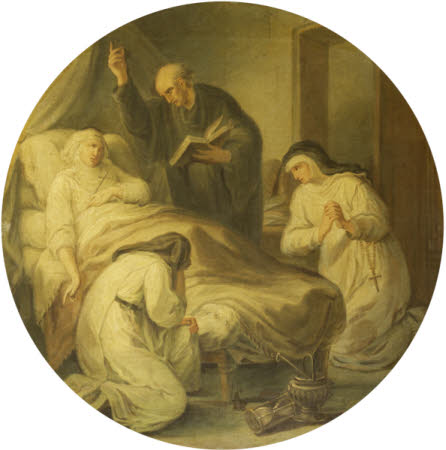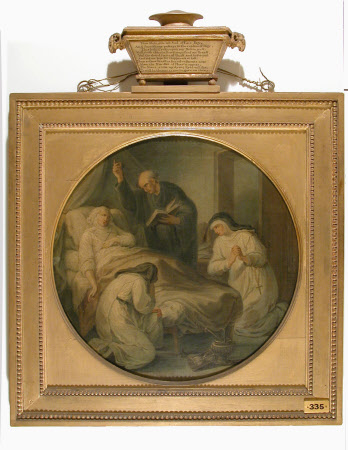The Death of Héloïse (after Angelica Kauffman)
Samuel Wale (Great Yarmouth 1721 – London 1786)
Category
Art / Oil paintings
Date
1782 - 1786
Materials
Oil on canvas
Measurements
406 mm (16 in) Diameter (circular)
Place of origin
England
Order this imageCollection
Stourhead, Wiltshire
NT 732303
Caption
Héloïse (or, Eloisa) is lying on her deathbed whilst a priest resides, gesticulating heavenwards, and two nuns kneel. This is the conclusion of the tragic mediaeval story between Héloïse (1101-1164), niece of Fulbert, a canon of Notre Dame Cathedral and Peter Abelard (1079-1142 ), a preacher and her teacher, who are immortalised in the poem by Alexander Pope (1688-1744) (1717) from which Kauffmann was inspired on more than one occasion. Their love for each other was discovered by Héloïse’s uncle who has Abelard castrated. She retreats to a convent whilst he, to the Abbey of Saint Denis, whence their famous correspondence began. This circular picture by a book illustrator is a copy from Thomas Burke's engraving of the original painting, once owned by the Earl of Exeter at Burghley House and now in Moravian Museum, Brno. It is painted in pale green and grey monotones, appropriate for the subject matter.
Summary
Oil painting on canvas,The Death of Héloïse, by Samuel Wale (Great Yarmouth 1721 – London 1786), after Angelica Kauffman (1741 - 1807), 1782 - 1786. A circular painting of Héloïse who lies on her death bed, holding a crucifix, while two nuns kneel at the foot and a priest (Abelard) incites her to fix her thoughts upon heaven. A tablet on the frame is inscribed with the lines from the poem by Alexander Pope (1688-1744), 'Eloisa to Abelard' (1717), beginning 'Thou, Abelard! the last sad office....' Copied from Thomas Burke's engraving of the original painting, which was at Burghley House and now in Moravian Museum, Brno.
Provenance
Acquired by Henry II Hoare (1705-85).Given to the National Trust along with the house, its grounds, and the rest of contents by Sir Henry Hugh Arthur Hoare, 6th Bt (1865 – 1947) in 1946.
Credit line
Stourhead, The Hoare Collection (National Trust)
Marks and inscriptions
Recto: A tablet on the frame is inscribed with the lines from Pope's Eloisa to Abelard: Thou, Abelard! the last sad office pay, And smooth my passage to the realms of day; See my lips tremble, and my eye-balls roll, Suck my last breath, and catch my flying soul! Ah no — in sacred vestments may'st thou stand, The hallow'd taper trembling in thy hand, Present the cross before my lifted eye, Teach me at once, and learn of me to die. Ah then, thy once-lov'd Eloisa see! It will be then no crime to gaze on me. See from my cheek the transient roses fly! See the last sparkle languish in my eye! Till ev'ry motion, pulse, and breath be o'er; And ev'n my Abelard be lov'd no more. O Death all-eloquent! you only prove What dust we dote on, when 'tis man we love.
Makers and roles
Samuel Wale (Great Yarmouth 1721 – London 1786), publisher after Angelica Kauffman RA (Chur 1741 – Rome 1807), publisher
References
Boerner 1979 C.G. Boerner, Angelika Kauffmann (1741-1810) und ihre Zeit: Graphik un Zeichungen von 1760- 1810, Neue Lagerliste 70, Dusseldorf 1979, no.144 (engraving by Burke)

